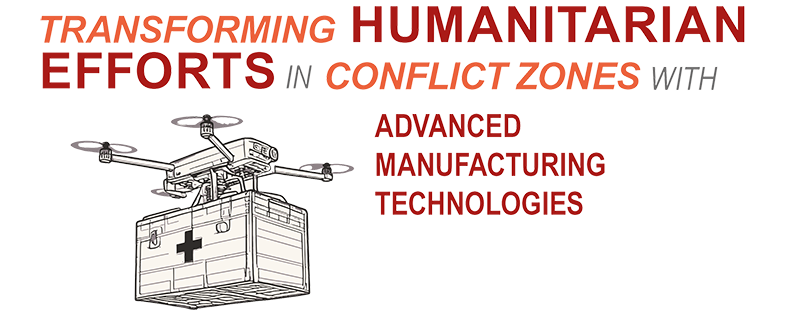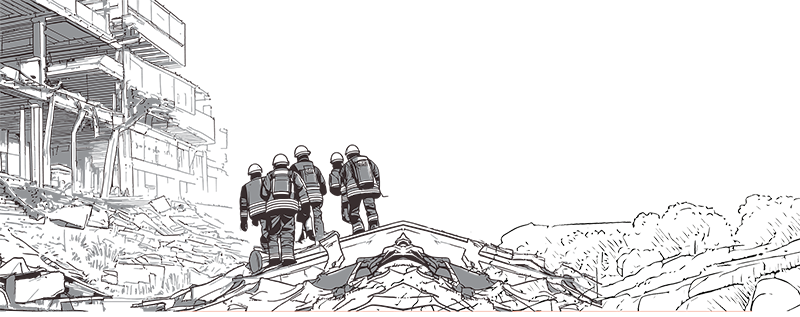
Humanitarian aid efforts in conflict zones or disaster areas are often faced with numerous challenges: limited resources, damaged infrastructure, and disrupted supply chains. The scale of these issues makes it difficult for traditional humanitarian responses to be as effective as they need to be. However, advanced manufacturing technologies are emerging as a key solution to overcome these barriers. Originally developed for industrial purposes, these innovations are now being repurposed for humanitarian aid, providing rapid, cost-effective, and life-saving solutions in some of the world’s most challenging environments.
Bridging Defence and Humanitarian Goals
Advanced manufacturing technologies, once perceived as tools primarily for industrial applications, have increasingly assumed a dual-purpose role in supporting humanitarian efforts. In conflict zones and disaster-stricken areas, where resources are scarce and logistical challenges are immense, these innovations provide lifesaving solutions that bridge defence and humanitarian goals. Defence programmes have long been at the forefront of technological innovation. From early radar systems to modern-day drones, the pursuit of military advancement has encouraged significant technological breakthroughs many of which are now being adapted to support vulnerable populations in conflict and disaster zones.
For instance, innovations in portable energy solutions and autonomous vehicles, initially designed to enhance operational efficiency for military forces, are now also being used for humanitarian purposes.
An example is the use of unmanned aerial vehicles (UAVs) or drones. While traditionally associated with reconnaissance and surveillance missions, drones are increasingly used for delivering medical supplies to inaccessible regions, monitoring displaced populations, and even assessing damage in post-conflict settings. The dual-purpose nature of these technologies underscores how investments in defence can be leveraged to address pressing humanitarian challenges.
Transforming Emergency and Disaster Response
When disaster strikes, whether natural or man-made, the speed and effectiveness of the response can mean the difference between life and death. Advanced manufacturing technologies, particularly those focusing on rapid production and deployment, are set to revolutionize emergency responses in conflict areas. 3D printing, for example, has emerged as a critical tool in creating customised and on-demand medical supplies. In scenarios where traditional supply chains are disrupted, 3D printers can produce prosthetics, surgical tools, and protective equipment locally, bypassing logistical bottlenecks. One example of 3D printing technology being used to produce prosthetic limbs for individuals injured by the violence occurred during the Syrian conflict. This not only provided medical support but also restored a sense of dignity and mobility to the victims (1,2)
Robotics also plays a significant role in disaster relief efforts. A key example of this technology in action was during the Fukushima Daiichi nuclear disaster in 2011. Following the catastrophic earthquake and tsunami that led to the meltdown of the nuclear plant, robots were deployed to access highly radioactive areas that were too dangerous for human workers. The “PackBot”, a ground-based robot, and aerial drones were used to inspect reactor buildings and assess radiation levels, enabling response teams to gather critical information without putting human lives at risk. These robots helped monitor situations in real-time, allowing for more informed decision-making and facilitating the subsequent recovery efforts. The use of robots in this disaster highlights their ability to operate in extreme conditions and their role in ensuring safety during complex emergency responses (3,4).
Moreover, mobile infrastructure solutions such as inflatable field hospitals, portable water purification units, and modular shelters offer scalable responses to emergencies. These solutions, enabled by advanced manufacturing processes, ensure that support can reach affected populations promptly and efficiently. The ability to adapt these technologies for humanitarian purposes demonstrates their transformative potential in addressing the unique challenges of conflict zones.
Supporting Vulnerable and Isolated Regions
One of the most profound impacts of advanced manufacturing technologies lies in their ability to support vulnerable and isolated regions, particularly those that are underserved or cut off due to conflict. Portable manufacturing units, for instance, enable local production of essential goods such as food, medicine, and construction items. These compact units, often designed to operate in extreme environments, provide a lifeline for communities in urgent need.
Energy-efficient systems are another area where advanced manufacturing excels. Solar-powered generators, developed with cutting-edge materials and processes, offer sustainable energy solutions for communities without access to traditional power grids.
Drones, once a staple of defence strategies, have become indispensable in providing technical support to isolated regions. From delivering vaccines to monitoring agricultural conditions, drones are proving to be a gamechanger.
For example, UNICEF used drones to deliver medical supplies in emergencies, such as in Malawi. The use of drones ensures that life-saving supplies can reach their destination quickly, even in places where traditional road transport is not feasible. The successful deployment of drones for emergency deliveries demonstrates how these technologies can dramatically improve medical accessibility in conflict zones and underserved regions (5).
The role of defence programmes in funding and deploying these solutions cannot be emphasised enough. Many of these technologies originate from defence research and development budgets, and their transition to humanitarian applications is often facilitated through partnerships with private industries and non-governmental organisations. This symbiotic relationship ensures that innovations designed for defence can also uplift communities in need, transforming lives in the process.
Driving Collaboration for Global Impact
To maximise the impact of advanced manufacturing technologies on humanitarian efforts, collaboration is key. Partnerships between defence programmes, industries, and humanitarian organisations are essential for developing, scaling, and deploying dual-purpose technologies. Shared investments in research and development can amplify the reach of these innovations. For example, public-private partnerships have been instrumental in advancing vaccine distribution technologies, such as ultra-cold storage units and automated dispensing systems. These systems, developed with contributions from defence budgets, played an important role in the global rollout of COVID-19 vaccines, including in conflict-affected areas.
The success of such collaborations highlights the need for policies and initiatives that prioritise equitable access to these advancements. Defence programmes, usually equipped with significant resources, can lead the charge by ensuring that humanitarian applications are considered during the development phase of new technologies. Governments and international bodies must also work together to establish frameworks that facilitate the sharing of these innovations across borders.
A promising initiative is the establishment of dual-use technology hubs, where defence and humanitarian stakeholders collaborate on projects that address both security and social needs. These hubs can serve as incubators for ideas that align with global priorities, developing innovation that can benefit all humanity. A growing initiative for dual-use technologies can be found in the form of collaborative spaces where both military and humanitarian sectors co-develop and refine technologies.
One example of such a programme is the Defence and Security Accelerator (DASA) in the UK, which funds and supports dual-use technologies that benefit both military and civilian sectors, including humanitarian needs. DASA has been involved in developing solutions such as the “Whole-Body Training Model,” originally designed to improve military trauma team training, now being adapted for civilian use to enhance disaster medical response.
Another DASA-backed initiative focuses on innovations to reduce ambulance cleaning times, which improves the speed and efficiency of emergency services, benefiting both military and civilian sectors. These projects demonstrate how DASA’s collaborative approach fosters technologies that address both security and humanitarian needs (6,7).
Innovating for Humanity
From bridging defence and humanitarian goals to transforming emergency responses and supporting isolated regions, advanced manufacturing technologies are reshaping the landscape of humanitarian efforts in conflict zones. These innovations hold the power to save lives and rebuild communities.
However, realising their full potential requires concerted efforts from all stakeholders. By developing collaboration between defence programmes, industries, and humanitarian organisations, and by pushing through policies that prioritise equitable access, we can ensure that these technologies are used for the greater good.

References: